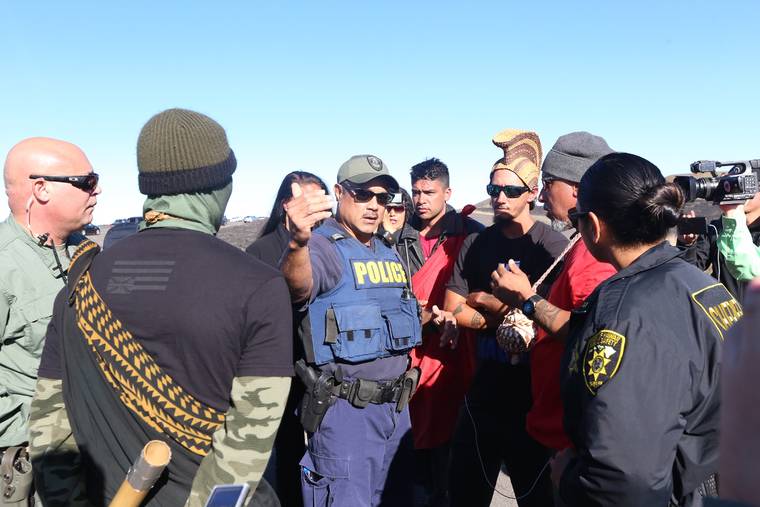The chiefs of police for the Big Island, Maui and Honolulu violated the law during the 2019 Thirty Meter Telescope protests, argued an attorney Thursday before the Hawaii Supreme Court.
In July 2019, when the protests began, Hawaii County Police Chief Paul Ferreira requested that the police departments of Maui and Honolulu send officers to assist Big Island police with managing the protesters occupying the Maunakea Access Road in opposition to the planned construction of TMT. Approximately 60 Honolulu officers and 27 Maui officers provided support on Maunakea.
However, Big Island resident E. Kalani Flores sued Ferreira, then-Honolulu Police Chief Susan Ballard and then-Maui Police Chief Tivoli Faaumu in 2019, arguing that they were in violation of Hawaii Revised Statute 52D-5, which determines how and when officers from one jurisdiction can be sent to a neighboring one.
The lawsuit was dismissed on a technicality, but was appealed and went before the state Intermediate Court of Appeals. Although that court ruled in favor of the police chiefs in January, the case was appealed again and was heard Thursday by the Supreme Court.
Flores’ attorney, Peter Olson, argued before the court that under 52D-5, officers can be brought to a neighboring island if they are pursuing an investigation that commenced within their own jurisdiction, and if the police chief on that neighboring island agrees to it. Because the Honolulu and Maui officers were not pursuing such an investigation, Olson said, they violated the first term of the statute.
“The statute is plain and unambiguous,” Olson said. “It is also specific to off-island police activity.
“We know as early as June 25, 2019, the police chiefs were planning to send non-Hawaii County police to Maunakea,” Olson continued. “This was about three weeks before anyone had assembled on Maunakea at Pu‘uhuluhulu.”
Olson said the agreement signed between the three police departments specifically invoked 52D-5, but because that statute’s first condition was not met, the law did not grant Ferreira the authority to request outside police assistance.
Supreme Court justices questioned Olson’s interpretation of the statute, suggesting that his reading was too narrow. Chief Justice Mark Recktenwald said Olson’s interpretation could feasibly limit counties’ ability to provide mutual aid during crises.
Olson responded by arguing that there are other statutes counties or the state could invoke to provide inter-county police aid. For example, he said, counties could invoke Hawaii Revised Statute 78-27, which allows for temporary inter-governmental assignments or exchanges.
However, Olson asserted that he believes HRS 52D-5 is the only state statute that allows county police officers to exert police authority on neighboring islands.
“So, based on what you’re arguing, you’re saying that, until the law is changed, each police department needs to hire many more police officers than it might otherwise need to account for these types of situations and just have these people on payroll or on hold, because they can’t request assistance from other counties?” asked Justice Sabrina McKenna.
“Yes,” Olson said. “They also would have the alternative of having assistance from the state sheriffs or (Division of Conservation and Resources Enforcement) officers. If it was an absolute emergency, they can ask the governor to … suspend 52D-5’s restriction. Or they can change the law.”
Robert Kohn, Deputy Corporation Counsel for the City and County of Honolulu, representing Ballard, argued against that interpretation, saying that such a restrictive reading would necessarily make rendering mutual aid nearly impossible. Instead, he said, 52D-5 only serves to prevent certain acts of police overreach, such as a department sending officers to a neighboring jurisdiction without authorization, but does not preclude sending officers in other situations.
“I’d like point to a very small word in 52D-5 that hasn’t received much attention … and that’s the word ‘if,’” Kohn said. “Flores seems to argue … that that ‘if’ means ‘if and only if.’ But the statute doesn’t compel such a reading, because such a reading would override all the others of mutual aid that are written into the Hawaii Revised Statutes.”
Hawaii County Deputy Corporation Counsel Lerisa Heroldt, representing Ferreira, argued that 52D-5 simply doesn’t apply to the situation at all, and that Ferreira was mistaken when he invoked it in the first place. Other statutes and the county charters grant counties the authority to request police assistance from other counties, Heroldt said, and regardless of whether Ferreira invoked the wrong statute, that does not mean he acted outside of his authority.
The court made no decision Thursday but took the parties’ arguments under advisement. A decision will be announced by the court at an undetermined future date.
Email Michael Brestovansky at mbrestovansky@hawaiitribune-herald.com.






